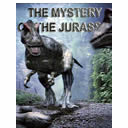The Mystery of the Jurassic
 For years scientists have been trying to find the mysterious evolutionary master key responsible for transforming the dinosaurs into world-beaters. In the early Jurassic, 200 million years ago, they were a relatively small group of primitive creatures. By the late Jurassic, 50 million years later, they had become the magnificent array of carnivores and giant plant eaters that would dominate the planet for millions of years. In between lies the mysterious period of the middle Jurassic in which all these changes must have happened. But what were they? What was it that transformed the dinosaurs?
For years scientists have been trying to find the mysterious evolutionary master key responsible for transforming the dinosaurs into world-beaters. In the early Jurassic, 200 million years ago, they were a relatively small group of primitive creatures. By the late Jurassic, 50 million years later, they had become the magnificent array of carnivores and giant plant eaters that would dominate the planet for millions of years. In between lies the mysterious period of the middle Jurassic in which all these changes must have happened. But what were they? What was it that transformed the dinosaurs?
Was there some terrible mass extinction? Had there been an amazing change in the environment? All this was speculation and theory. How and where would evidence come to light? Fossils from the middle Jurassic are incredibly rare. All anyone had to go on were a few small outcrops of rock dotted around the world.
Then a treasure trove of fossils emerged from the midst of an Argentinian wilderness in the 1990s; thousands of square miles of mid-Jurassic rocks. On their first season in the field, paleontologist Oliver Rauhut and his team unearthed two giant meat-eating dinosaurs and six huge long-necked dinosaurs. And there was much more: early mammals, crocodiles, fish and even plant life. They had uncovered a complete mid-Jurassic eco-system, a wonderful snapshot of life from this dark age of dinosaurs.
"It's as if someone has unearthed a holy grail of dinosaur palaeontology," says British geologist, Dr Phil Manning. Oliver Rauhut describes the site as, "an extraordinary window on the mid-Jurassic." Above all, the hope is that this site may contain all the information they need to find the mysterious evolutionary forces that have eluded palaeontologists for so long.




stops playing at 4:09 min.
Pretty informative, but since it's from 2002, a little dated. And the dinosaur animation is kinda cr*p.
Are you guys on drugs? Or just slow minded? There is no mystery to why there were giant plant eaters and what is this hoopla about their disappearance? The Earth changes slowly and people don't realize that 200 million years is enough to change any given species within a 4:1 ration span, in other words 50 Million years is plenty to change everything on Earth. In this time, the atmosphere make up and even the core of the Earth was substantial enough to make all the species different from the Fossil remains we see today. In other words, atmosphere differences that were extremely different to the 75% nitrogen 25% other mix of gases of today. The core of the Earth was less hotter than today and caused less gravity attraction which caused greater bones in those species as well as bigger insects and plants.
From gas chromatography results, carbon dating, and soil samples taking within and around the Fossil remains, this proves all of the explanations listed above including iridium which exists as a thin layer around much of Earth. That also explains the proof of disappearance and extinction from a devastating Meteor impact. You people make me sick. Just stick to science for once please.
Good doc, explains the sudden diversity among dinosaurs rather well. I knew it had something to do with the split of Pangea, but these guys really crystallized the idea. Gotta love BBC.
Aside - anyone know the name of the symphony song in the middle of the third part of the doc? I could swear I've heard it in a western movie somewhere...
one aspect of speciation the documentary dealt with, which i found somewhat unconvincing, was the requirement that, along with climate change, isolation was also necessary to drive speciation (new species creation).
when new favorable climates arise (as, say, due to new verdant coastal forests springing up in response to the breakup of pangea), this would create new & favorable habitats upon which incipient speciating populations could adapt to, specialize upon, speciate within.
no need to force animals to forage there under the lash of a proximity enforced by some barrier to their exodus. this is called parapatric speciation, and requires NO geographic barrier. the doc muddled this point, i believe.
the music was a little melodramatic too - other than those criticisms, though - the subject matter was very interesting.
As a Dino-lover I gotta see this.
It seems that dinosaurs are rather what this documentary is about. I think dinosaurs are the main topic of this documentary. If I were to rate this documentary out of ten stars, I'd say it was about dinosaurs.
Good documentary! Not sure how Charles B considers this to be religious fervor, it's 100% scientific and in no way makes any unscientific claims. They show that the original mammals as well as the dinosaurs were greatly affected by the first splitting of the great continent of Pangaea. The new environments created allowed for greater diversity of life. This is demonstrated when the scientists show fossilized proof that back before the split all early mammalian ancestors have the same anatomical features, whereas after the break of the continent those basic features had been slightly changed. The same happened in the dinosaurs, while the basic anatomical features of all dinosaurs were the same before Pangaea split, certain anatomical features, the enlarged thigh bone being the first, changed once the continent was split. As for the claim about Oliver the Chimp possibly confusing the future fossil record. Scientists, unlike religious nuts, use evidence to back up claims. When a small hobbit like creature was found in 2003, scientists first thought it could be explained by natural pathology, it had to be a modern human with some sort of disease causing extremely small brain and body size. As they studied further, they realized it was in fact a different species, Homo-floresiensis, a find that changed how we view human evolution. While Charles B likes to think science can be confused so easily, with research, we ultimately have a much better understanding of the world we live in.
Marc - Dinosaurs have their heads out in-front of their feet, in order to balance they need some sort of counterweight, that is where the tail comes in. As for your question about it being in a resting position. That is the resting position! It's similar to a Giraffe's neck, it looks like they have to spend a lot of effort in order to keep it up and suspended like that, but really because of how it's designed it's effortless. In fact, it's a fairly difficult process for a giraffe to lower it's neck. Hopefully you see the comparison I'm drawing, while it looks like a dinosaur is holding it's tail upright, that is in fact the natural position for it, resting it down on the ground would in fact not be 'resting' it at all.
I sure am glad the Charles B. is not making his own docs lol!!!
Charles B. - I too was wondering about the conclusion of dinosaur vicariance all based on a statistical sample consisting of one leg bone. Though I believe in the theory of evolution, I agree that a sample size of one bone is a bit thin.
The problem for me is how scientists in general like to speak so confidently and authoritatively about a theory right up until they find contrary evidence and then they sort of sweep their old theory under the rug, change their story, and then present the new story (theory) with equal confidence and certainty. Science is supposed to evolve in this way, but I have issues with the style of presentation of the scientist.
As a side note - evolution can readily be seen in microbes because they reproduce so rapidly and therefore rapidly go though many generations. This can be seen particularly in how they adapt to antibiotics. There's no reason why evolution wouldn't occur in larger animals too but at a slower pace.
Interesting how every dinosaur no matter its size, always has a tail that's held up high in the air. Some of these tails are massive (and therefore heavy) yet there they are floating effortlessly up in the air. Resting their tails on the ground when they aren't running seems reasonable but they never do. Is this just some fad for dinosaur appearance or are there any facts supporting this?
Interesting doc, but ultimately, I'm disappointed. Evolutionists at their most presumptive.
From a single tiny mouse (mammal) jawbone FRAGMENT, they try to prove "evolution" in mammals by a tiny "groove" in the jawbone, ASSUMING the jawbone came from the same species found in other places, without a "groove" in the jawbone. One tiny "groove" proves nothing.
And then from a "bulge" in a though bone from a dinosaur they try to prove it's an example of "vicariance". Admittedly the scientist looked over the whole fossil group looking for the "slightest" difference in any of them to prove their supposition until they found it.
Interesting doc had it not been for the religious fervor at which they try to prove something that they ultimately have again no fossils to prove.
I got the impression that they dated the fossils by the kind of rocks they were in and the kind of rocks they were in by the kind of fossils they possessed. Now that's circular logic to me. No indication of how they dated the rocks was given, and no indication how they decided which was the "youngest" fossil except that it was identical in every way to other fossils except for a small bulge on the leg bone.
God help us all had 'Oliver the Chimp" ever made it into the fossil record. His oddness, while still being 100% Chimpanzee could have filled books with all sorts of evolutionary religious gibberish for years. Glad he's still living so we could study his DNA.
Nonetheless, I liked the doc! I never get tired of dinos. I would have loved to have been a full-time fossil hunter. Now that would have been very exciting I think. :-)
Good Doc..
Interesting Information
Is that a Doom II sound effect at 10:43 (and earlier)? Sounds like something from the final level of Doom II to me.
Good Doc.